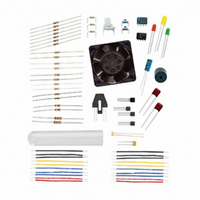130-28176 Parallax Inc, 130-28176 Datasheet - Page 75

130-28176
Manufacturer Part Number
130-28176
Description
KIT PARTS PROCESS CONTROL
Manufacturer
Parallax Inc
Specifications of 130-28176
Accessory Type
Education Kit
Product
Microcontroller Accessories
Lead Free Status / RoHS Status
Contains lead / RoHS non-compliant
For Use With/related Products
Board of Education Full Kit
Lead Free Status / RoHS Status
Lead free / RoHS Compliant, Contains lead / RoHS non-compliant
- Current page: 75 of 330
- Download datasheet (11Mb)
amount of light that is produced (lumens) as well as the heat produced and dissipated to
the air around it. Any device that has current flowing through it and a voltage drop
across it coverts electricity into power. This power may be useful work (light, motion) or
heat to be dissipated – which could also be useful at times, such as your clothes dryer.
When the power takes the form of heat, it must be dissipated from the device either by
convection to the air or through other means. The CPU in your computer system
consumes a large amount of power, and if the heat is not removed, damage to the CPU
will quickly occur. Heat sinks provide heat conduction from the device, a greater area of
cooling and often fans are added for forced convection to remove heat more efficiently.
Transistors, such as the ones in your CPU, have current flowing through them and have a
voltage drop across them. Since a transistor operates in 3 distinct areas, when is the most
power consumed?
Maximum power is used by the transistor when it is mid-point biased where V
V
For our circuit, the highest power can be calculated:
The maximum power that the 2N3904 can dissipate (P
sinks and fans. We are well within the device’s specifications.
CUTOFF
•
•
When in cutoff, the voltage drop is at maximum (V
minimum (theoretically 0).
When in saturation, the current flow is at maximum (I
minimum (0.3 V).
P
Vdd = 5 V, I
P
and current is ½ I
Q1 Max
Q1 Max
DC Power Dissipation: The power dissipated by an element in a DC circuit is given by the
voltage across the element multiplied by the current flowing through it:
Power = Voltage x Current
P = VI
= ½ (Vdd) x ½ (I
= (0.5 )(5 V) x (0.5)(5 mA) = 6.25 mW
SAT
= 5 mA
SAT
(these occur at the same time).
SAT
)
D
) is 200 mW without adding heat
CUTOFF
SAT
) but the voltage drop is
), but current flow is
CE
is ½
Related parts for 130-28176
Image
Part Number
Description
Manufacturer
Datasheet
Request
R

Part Number:
Description:
KIT PROPELLER EDU PROJECT PARTS
Manufacturer:
Parallax Inc
Datasheet:

Part Number:
Description:
KIT PARTS SMART SENSORS
Manufacturer:
Parallax Inc
Datasheet:

Part Number:
Description:
Microcontroller Modules & Accessories DISCONTINUED BY PARALLAX
Manufacturer:
Parallax Inc

Part Number:
Description:
BOOK UNDERSTANDING SIGNALS
Manufacturer:
Parallax Inc
Datasheet:

Part Number:
Description:
COMPETITION RING FOR SUMOBOT
Manufacturer:
Parallax Inc
Datasheet:

Part Number:
Description:
TEXT INFRARED REMOTE FOR BOE-BOT
Manufacturer:
Parallax Inc
Datasheet:

Part Number:
Description:
Microcontroller Modules & Accessories DISCONTINUED BY PARALLAX
Manufacturer:
Parallax Inc

Part Number:
Description:
BOOK UNDERSTANDING SIGNALS
Manufacturer:
Parallax Inc
Datasheet:

Part Number:
Description:
BOARD EXPERIMENT+LCD NX-1000
Manufacturer:
Parallax Inc
Datasheet:

Part Number:
Description:
IC MCU 2K FLASH 50MHZ SO-18
Manufacturer:
Parallax Inc
Datasheet:













